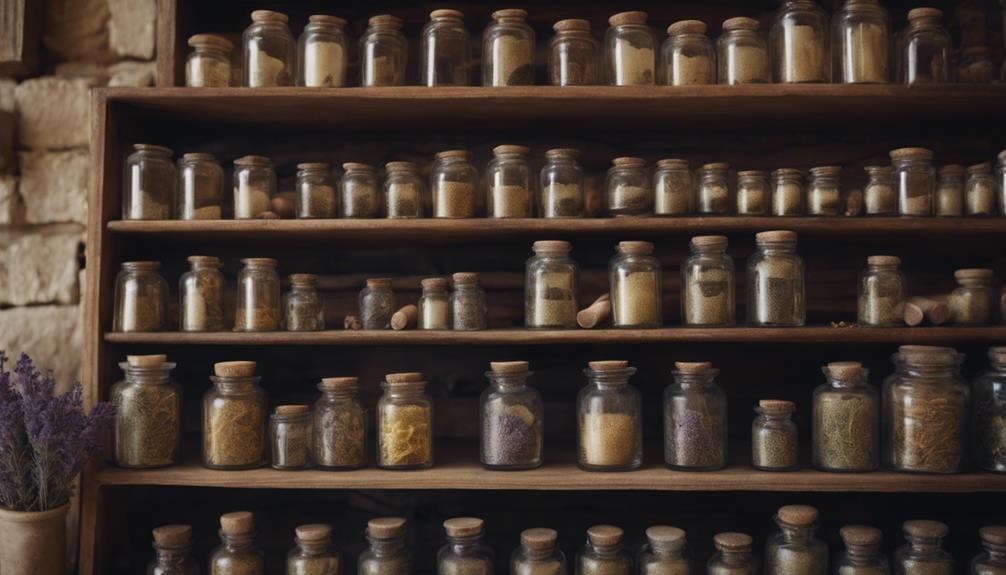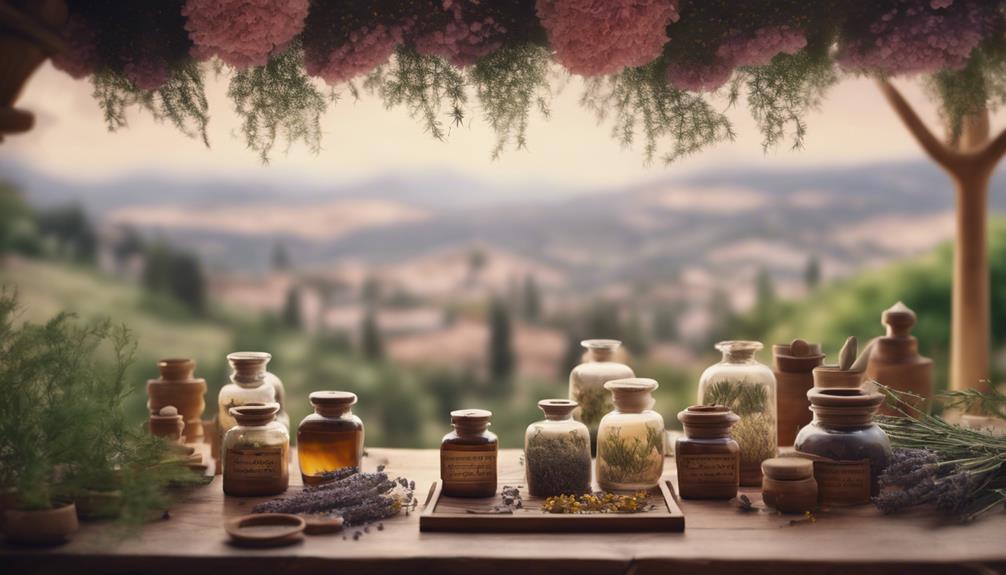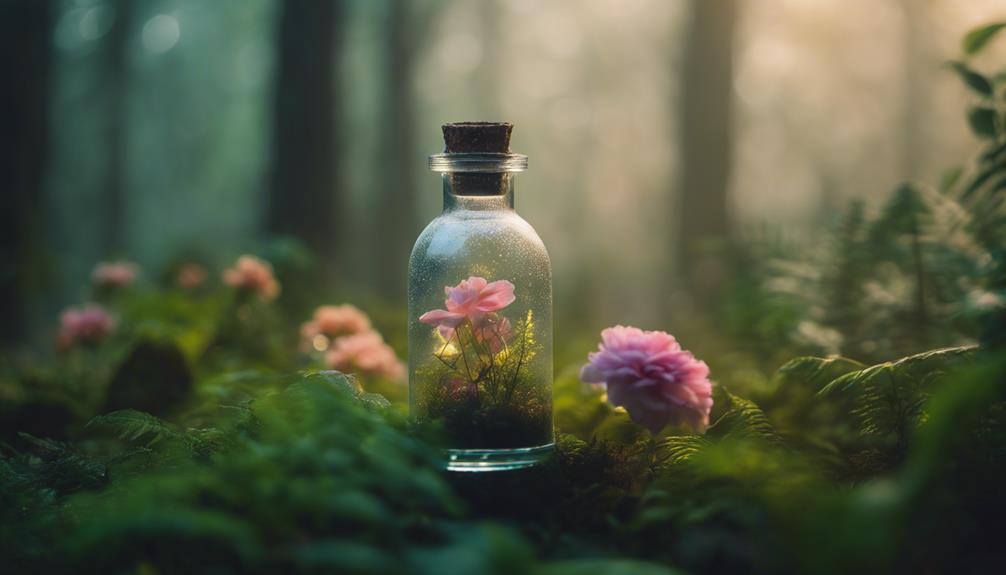We've grown up surrounded by the profound wisdom of traditional Lebanese herbal remedies, where the ancient knowledge of harnessing the medicinal properties of plants has been passed down through generations, weaving a rich tapestry of cultural identity and natural healing. Sage, thyme, marjoram, and zaatar are common medicinal herbs used to treatCold, digestive issues, and skin conditions. Herbal teas like sage and yansoun offer calming effects, while lemon juice and rosewater provide natural skincare solutions. By embracing these traditional remedies, we can explore the many benefits of Lebanon's vibrant herbology, and discover more about the cultural significance of these natural healing practices.
Key Takeaways
• Lebanese herbal remedies rely on traditional plants like sage, thyme, and zaatar for their medicinal properties and therapeutic benefits.
• Zaatar, in particular, offers anti-inflammatory and antioxidant properties, regulating gut microbiota and promoting overall well-being.
• Herbal teas, such as sage, yansoun, and chamomile, are popular remedies for colds, calming effects, and digestive issues.
• Natural ingredients like rosewater, lemon juice, and qass3en water are used in skincare routines for their moisturizing and toning properties.
• Combining herbs and plants, such as fennel seeds, garlic, and honey, can provide relief from common ailments like colds, flu, and digestive issues.
Traditional Lebanese Herbal Remedies
In our pursuit of natural wellness, we often turn to traditional Lebanese herbal remedies, which have been a cornerstone of our cultural heritage for generations. These remedies have been passed down through generations, and their medicinal properties have been revered for their effectiveness in treating common ailments.
Lebanese medicinal practices have always emphasized the importance of natural healing, and our ancestors relied heavily on the therapeutic benefits of plants to maintain health and wellness. As a result, traditional Lebanese herbal remedies have become an integral part of our cultural identity.
We've grown up with stories of our grandparents using herbs like sage, thyme, and zaatar to treat everything from colds to skin problems. These remedies have been tried and tested, and their effectiveness has been proven time and time again. In our households, we often rely on these traditional remedies as a natural alternative to conventional medicine.
Common Medicinal Herbs in Lebanon

We frequently turn to a selection of trusted medicinal herbs in Lebanon, including sage, thyme, marjoram, zaatar, and fennel, to address various health concerns. These herbs have been used for generations in traditional Lebanese medicine to treat ailments like colds, digestive issues, and skin conditions. The Lamiaceae family, which includes sage, thyme, and marjoram, is renowned for its aromatic and therapeutic properties.
Some of the key benefits of these medicinal herbs include:
- Soothing digestive issues: Fennel seeds, anise, and garlic are commonly used to aid digestion and alleviate symptoms like bloating and cramps.
- Relieving respiratory issues: Thyme and zaatar are often used to soothe sore throats and alleviate respiratory issues like coughs and congestion.
- Treating skin conditions: Marjoram and sage have antibacterial properties, making them effective in treating skin conditions like acne and wounds.
These medicinal herbs have been an integral part of Lebanese traditional medicine for centuries, and their medicinal properties continue to be valued today.
Herbal Teas for Health Benefits

As we reach for a soothing cup to ease our discomfort, herbal teas have become an essential part of Lebanon's health regimen. We've found that herbal teas offer a natural and comforting way to alleviate various health issues.
For instance, Sage tea is a popular remedy for treating colds and joint inflammation. Yansoun tea, on the other hand, is favored for its calming effects, helping us unwind after a long day.
When we're struggling with a sore throat, a warm cup of Mint tea is just what the doctor ordered. Chamomile tea is another staple in Lebanese herbal remedies, providing quick relief for upset stomachs.
Last but not least, Zhourat tea is a beloved favorite, promoting overall well-being and health. These herbal teas have become an integral part of our self-care routine, offering a gentle and effective way to address common health concerns.
Natural Ingredients for Skincare

We've long turned to natural ingredients to pamper and protect our skin, leveraging the potency of Lebanon's herbal treasures. Our grandmothers taught us the secrets of herbal skincare, passed down through generations.
We've learned that rosewater, for instance, is a gentle moisturizer, soothing sunburn and acting as a natural toner.
Some of the most effective natural ingredients for skincare include:
- Rosewater, which moisturizes and soothes the skin
- Lemon juice, rich in vitamin C, which helps combat cold and flu
- Herbal remedies like Qass3en water, derived from Sage and Maryamieh herbs, which eases tummy aches and serves as a natural remedy for digestive issues
These natural ingredients have been used for centuries to maintain healthy, glowing skin. By incorporating them into our skincare routine, we can harness the power of Lebanon's herbal heritage to achieve radiant, healthy-looking skin.
Lebanese Medicinal and Aromatic Plants

Beyond the domain of skincare, Lebanon's herbal treasures extend to a diverse array of medicinal and aromatic plants, renowned for their therapeutic properties and culinary uses. We're fortunate to have an abundance of herbal remedies at our fingertips, thanks to the country's rich botanical heritage.
Lebanese medicinal and aromatic plants like Sage, Thyme, Marjoram, Zatar, Fennel, and Rosemary are packed with bioactive compounds that offer potential health benefits for various ailments. Traditional Lebanese herbal remedies effectively utilize these plants for their medicinal, culinary, and aromatic properties.
These herbal remedies are deeply rooted in our cultural, historical, and religious practices, reflecting a holistic approach to health and well-being in Lebanon. By harnessing the therapeutic powers of these plants, we can create effective herbal remedies that promote overall wellness.
From soothing digestive issues to alleviating respiratory problems, Lebanese medicinal and aromatic plants have been trusted for generations as a natural and effective way to maintain health.
Complementary Alternative Medicine Use

As we explore the domain of Complementary Alternative Medicine (CAM) in Lebanon, we're struck by the prevalence of herbal medicine usage and the diverse range of alternative therapy approaches that coexist alongside conventional healthcare.
It's clear that many Lebanese individuals are seeking out these complementary therapies to address various health concerns, and we're interested in examining the driving forces behind this trend.
Herbal Medicine Usage
In Lebanon, nearly one-third of adults, or 29.87%, have turned to Complementary Alternative Medicine (CAM) to tackle various health concerns. We've found that herbal medicine, in particular, plays a significant role in this trend. Folk herbs, a traditional remedy, are the most popular type of CAM, with 75% of users opting for this method.
When it comes to herbal medicine usage, we've noticed that people turn to it for specific reasons, including:
- Treating flu and digestion/stomach issues
- Boosting energy levels
- Managing chronic illnesses
It's interesting to note that people rely on various sources for CAM information, such as family traditions, personal choice, friends, media, and health practitioners.
Additionally, CAM use is more prevalent among middle-aged individuals, females, those with higher household incomes, and patients with chronic diseases. As we delve deeper into the world of herbal medicine, it's essential to understand the motivations and demographics behind its usage.
Alternative Therapy Approaches
We often turn to alternative therapy approaches when conventional medicine falls short, and in Lebanon, Complementary Alternative Medicine (CAM) has become an integral part of the healthcare landscape. In fact, a significant 29.87% of Lebanese adults use CAM, which includes natural health products, folk herbs, and vitamins and minerals.
We use CAM for various reasons, including treating flu, digestion issues, boosting energy, enhancing immunity, and managing chronic illnesses. Many of us believe in the advantages of CAM, often learning about it through family traditions.
Surprisingly, CAM use is higher among middle-aged individuals, females, those with higher incomes, and individuals with chronic diseases. We find comfort in natural remedies, which is why CAM has become a popular choice.
As we navigate the world of herbal remedies, understanding the role of CAM in our healthcare system is crucial. By acknowledging its significance, we can work together to create a more holistic approach to wellness.
Benefits of Lebanese Herbal Mixture

Among the numerous benefits of the Lebanese herbal mixture Zaatar, one of the most significant advantages is its potential to positively impact gut health and mitigate chronic diseases. As we explore further into the properties of Zaatar, we find that its components have been used to influence gut microbiota, oxidative stress, inflammation, and obesity. This is likely due to the diverse bioactive compounds present in the mixture.
Zaatar's traditional uses have been widely recognized, and incorporating it into the Mediterranean diet may aid in preventing chronic and cardio-metabolic diseases.
We've found that:
- Zaatar's anti-inflammatory properties can help reduce chronic inflammation
- The antioxidant properties of Zaatar can mitigate oxidative stress
- The bioactive compounds in Zaatar may help regulate gut microbiota, leading to improved overall health
While further human studies are needed to fully explore the potential health benefits of Zaatar, the existing research suggests that this Lebanese herbal mixture is a valuable addition to a healthy diet. As we continue to investigate the world of herbal remedies, it's clear that Zaatar is a valuable asset worth exploring further.
Most Used Natural Remedies

As we shift our focus to the most commonly used natural remedies in Lebanon, we find a variety of timeless treatments that have been passed down through generations. Among these remedies, lemon juice stands out for its high vitamin C content, helping to combat colds, flu, and fatigue while boosting immunity and detoxifying the body.
Sage tea is another popular choice, offering soothing relief for colds and joint inflammation. For a sore throat, honey is a trusted natural cough suppressant and soother, packed with antioxidants and wound-healing properties.
Fennel seeds are also widely used, providing fresh breath and digestive support. Meanwhile, garlic cloves and onions have been used for centuries, with garlic acting as a natural antibiotic and onions reducing inflammation, making them effective against infections and acne.
These natural remedies have been trusted by generations, and their ongoing popularity is a confirmation of their effectiveness. By incorporating these remedies into our daily lives, we can harness the power of nature to promote health and wellness.
Herbology in Lebanese Culture

In Lebanon, a profound appreciation for the medicinal properties of plants has been woven into the fabric of our cultural heritage. Traditional herbal remedies have long been relied upon to prevent and treat various health issues. We've grown up with these remedies, passed down through generations, and they've become an integral part of our daily lives.
Our herbology is deeply rooted in traditional practices and beliefs, incorporating a wide range of herbs and plants for medicinal purposes. We believe in a holistic approach to health, focusing on natural solutions and the healing properties of plants.
Some key aspects of herbology in Lebanese culture include:
- The use of herbal remedies to promote overall well-being and prevent illnesses
- The combination of specific herbs and plants to address various health concerns
- The interconnectedness of herbology with our culinary traditions, where herbs and plants are used to enhance flavor and nutritional value
Frequently Asked Questions
What Herbs Grow in Lebanon?
We find that Lebanon's Mediterranean climate is perfect for growing a variety of herbs. We're familiar with Zaatar, Thyme, and Sage, which are staples in Lebanese cuisine and traditional medicine.
Other herbs like Marjoram, Fennel, and Rosemary also thrive in the region. The country's diverse flora contributes to its rich cultural and culinary heritage, with these herbs offering flavor and medicinal benefits.
What Are the 7 Natural in Traditional Arabic Medicine?
We often assume traditional Arabic medicine is all about exotic spices and mysterious potions, but the reality is much simpler.
In traditional Arabic medicine, we rely on 7 natural ingredients: garlic, onions, anise, sage, chamomile, fennel seeds, and honey.
These humble heroes have been used for centuries to promote health and wellbeing. By incorporating these natural wonders into our daily lives, we can tap into their soothing, healing, and therapeutic properties.
What Is the Native Plant of the Lebanese?
We're often asked about the native plant of Lebanon, and the answer is clear: it's the majestic Cedar of Lebanon (Cedrus libani).
This iconic tree has been a symbol of the country for thousands of years, representing immortality, resilience, and strength. In fact, it's so integral to Lebanese identity that it's featured on the national flag.
What Is the Most Common Herbal Medicine?
We've uncovered the answer! As we explore the world of herbal medicines, we discover that the most common one is Zaatar.
This traditional Lebanese herb blend is a staple in many households, packed with beneficial properties. Zaatar typically consists of thyme, sumac, sesame, and other aromatic herbs, making it a go-to remedy for various health benefits.
Conclusion
As we explore the world of Lebanese herbal remedies, we uncover a treasure trove of natural wonders, where ancient traditions meet modern-day benefits.
Like a rich tapestry, the country's medicinal plants weave together to form a vibrant fabric of health and wellness.
From soothing teas to nourishing skincare, these herbs whisper secrets of the past, guiding us toward a brighter, more natural future.










